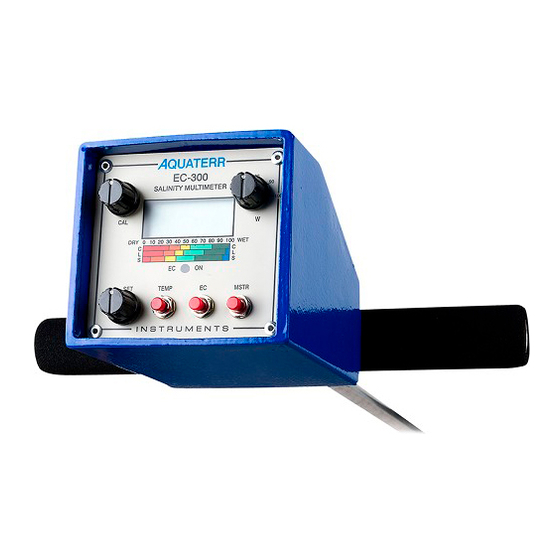AQUATERR INSTRUMENTS T-300 사용자 설명서 - 페이지 5
{카테고리_이름} AQUATERR INSTRUMENTS T-300에 대한 사용자 설명서을 온라인으로 검색하거나 PDF를 다운로드하세요. AQUATERR INSTRUMENTS T-300 11 페이지.

While your Meter is easy to use, four important steps must be performed to ensure
repeatable results.
1. CALIBRATE the moisture section in IRRIGATION water. Check its calibration every several
hours.
2. WIPE THE PROBE with a towel between EACH test, remove all excess dirt. Dirt carryover
will cause errors in future readings.
3. The probe tip (end 5 inches) must be in INTIMATE contact with the soil.
4. Test SEVERAL spots at EACH location, and then average the results.
Calibrating your Meter for moisture takes just a few seconds. The moisture calibration should
be performed before testing and at regular intervals during testing (once every several hours).
This will help ensure accuracy and repeatability of the tests.
1. Fully immerse the sensor end in IRRIGATION water, keeping the meter end out of the
water at all times. If you have very soft water (EC below 200 ppm or 30 ms), call technical
service for calibration recommendations.
2. While the probe is in the water, push the "MSTR" button (the only push button on the
Moisture Meters). While pushing down on the "MSTR" button, turn the "SET" knob until the
meter reads 100 (clockwise increases the meter reading).
3. The Moisture Meter is now ready to use.
There are a couple of important things to remember when measuring the moisture content:
make sure the probe is contacting the soil and take several readings about one foot apart at
each location to make sure that there is not a problem with one location.
1. Push the probe into the soil to desired depth. If the ground is too hard, use an auger or a
piece of pipe to make a hole to the desired test depth, and then push the probe into the
soil. The sensing window must be in contact with the soil to get repeatable results.
2. Push the "MSTR" button. The meter reading indicates the soil moisture level.
3. WIPE off the probe with a towel between readings.
FOUR CRITICAL STEPS
CALIBRATING THE MOISTURE FUNCTION
MEASURING SOIL MOISTURE CONTENT
5
